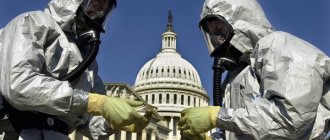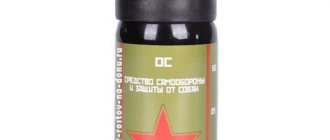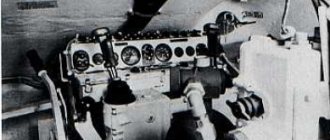On April 24, 1915, on a front line near the city of Ypres, French and British soldiers noticed a strange yellow-green cloud that was rapidly moving towards them. It seemed that nothing foreshadowed trouble, but when this fog reached the first line of trenches, the people in it began to fall, cough, suffocate and die.
This day became the official date of the first massive use of chemical weapons. The German army, on a six-kilometer-wide front, released 168 tons of chlorine towards enemy trenches. The poison affected 15 thousand people, of which 5 thousand died almost instantly, and the survivors died later in hospitals or remained disabled for life. After using the gas, the German troops went on the attack and occupied enemy positions without losses, because there was no one left to defend them.
The first use of chemical weapons was considered successful, so it soon became a real nightmare for soldiers on the opposing sides. All countries participating in the conflict used chemical warfare agents: chemical weapons became a real “calling card” of the First World War. By the way, the city of Ypres was “lucky” in this regard: two years later, the Germans in the same area used dichlorodiethyl sulfide against the French, a blister chemical weapon called “mustard gas.”
This small town, like Hiroshima, has become a symbol of one of the worst crimes against humanity.
On May 31, 1915, chemical weapons were used against the Russian army for the first time - the Germans used phosgene. The gas cloud was mistaken for camouflage and even more soldiers were transferred to the front line. The consequences of the gas attack were terrible: 9 thousand people died a painful death, even the grass died due to the effects of the poison.
History of chemical weapons
Chemical weapons began to be used by humans a very long time ago - long before the Copper Age. Back then people used bows with poisoned arrows. After all, it is much easier to use poison, which will surely slowly kill the animal, than to run after it.
The first toxins were extracted from plants - humans obtained them from varieties of the acocanthera plant. This poison causes cardiac arrest.
With the advent of civilizations, bans on the use of the first chemical weapons began, but these bans were violated - Alexander the Great used all chemicals known at that time in the war against India. His soldiers poisoned water wells and food warehouses. In ancient Greece, the roots of the earthen grass were used to poison wells.
In the second half of the Middle Ages, alchemy, the predecessor of chemistry, began to develop rapidly. Acrid smoke began to appear, driving away the enemy.
Physiological effects
Depending on the type of impact on the human body, toxins are divided into five groups:
- nervous activity;
- Blister on the skin;
- often poisonous;
- Suffocating;
- psychochemical effect.
Nerve toxins cause damage to the central nervous system. According to the US Army command, such a PS should be used to defeat an unprotected enemy worker or to surprise a worker wearing gas masks. In the latter case, this means that the personnel will not have time to use gas masks in time. The main purpose of using nerve gas is to quickly and en masse incapacitate personnel with as many lethal consequences as possible.
Chemicals that cause skin blisters are added primarily through the skin, and when used as aerosols and vapors, also through the respiratory system.
General toxic OM affects the respiratory system, which stops oxidative processes in the tissues of the body.
Choking mainly affects the lungs.
PS having a psychochemical effect appeared in the arsenal of a number of foreign countries relatively recently. They are capable of shutting down the enemy’s vital functions for some time. These toxic substances, acting on the central nervous system, disrupt normal mental activity of a person or cause mental disabilities such as temporary blindness, deafness, anxiety, and limitation of motor functions of various organs. It is characteristic of these substances that they require 1000 times higher doses to cause fatal injury than to cause disability.
According to the US, PS, along with deadly poisons, is said to weaken the will and steadfastness of enemy troops in battle.
First use of chemical weapons
The French were the first to use chemical weapons. This happened at the beginning of the First World War. They say that safety rules are written in blood. Safety rules for using chemical weapons are no exception. At first there were no rules, there was only one piece of advice - when throwing grenades filled with poisonous gases, you must take into account the direction of the wind. Also, there have been no specific, tested substances that kill people 100% of the time. There were gases that did not kill, but simply caused hallucinations or mild suffocation.
On April 22, 1915, the German armed forces used mustard gas. This substance is very toxic: it severely injures the mucous membrane of the eye and respiratory organs. After using mustard gas, the French and Germans lost approximately 100-120 thousand people. And throughout the First World War, 1.5 million people died from chemical weapons.
In the first 50 years of the 20th century, chemical weapons were used everywhere - against uprisings, riots and civilians.
Sarin, herd, VX and Novichok
The first chemical warfare agents were initially created for good purposes. For example, pesticides are plant protection products. But they were often used completely for other purposes.
In the 1930s, in an attempt to create more powerful pesticides, German scientists developed a group of phosphorus-containing substances. These were sarin, tabun, soman and cyclosarin. They were called the G-group (G - German). They never became agricultural assistants. Instead, they became the first nerve agents and laid the foundation for an entire class of chemical warfare agents. After them, VX substances and those same “newbies” appeared.
Although G-Group was immediately put into service by the Third Reich, these substances were not used during World War II. The experience of past years has shown the insufficient versatility and complexity of using chemical warfare agents. All G-group substances contain phosphorus. In their pure form, both sarin and tabun are poisonous liquids, but they easily evaporate and turn into an even more poisonous gas.
Sarin, tabun and other representatives of the G-group change the transmission of nerve impulses. We have already talked about acetylcholine, which transmits signals from nerve endings to muscles. When acetylcholine is between the end of the nerve fiber and the cell being excited, the signal is sent. Then, when the signal should stop, acetylcholine is no longer needed, and it is destroyed by a special enzyme - acetylcholinesterase. At this moment the signal disappears.
So, sarin and tabun (and other chemical agents of the same group) slow down the action of the enzyme acetylcholinesterase, acetylcholine is not destroyed. It continues to transmit signals to the muscles. Outwardly, this is expressed as convulsions, constriction of the pupils (due to this loss of vision), overexcitation, drooling, disruption of the heart and even paralysis. The lethality of these substances is high and occurs due to respiratory arrest. And not after a few hours, as in the case of chlorine or mustard gas, but immediately.
But a person can be saved if treatment is started immediately. Fortunately, there is an available antidote, the early administration of which can save the life of a poisoned person - atropine.
Tokyo subway attack, March 1995
Photo: Chiaki Tsukumo/AP
In 1995, there was a terrorist attack on the Tokyo subway. During rush hour, terrorists released sarin into the subway. More than 10 people were killed and 50 were injured. During the Iran-Iraq War in the 1980s, nerve agents were actively used.
In 1988, a chemical attack occurred in Iraqi Kurdistan. This day was called Bloody Friday. As a result of the chemical attack, between 3 and 5 thousand people died. A medical investigation showed that a mixture of mustard gas and one of the nerve agents was used. It was probably Tabun, Sarin, or VX gas.
By the way, about him. VX gas is actually an oily liquid. Calling it a gas is not entirely correct. VX can release fumes, but not as strongly as sarin. Therefore, it can be used as an aerosol or spray. It is more persistent in the environment and can persist for several weeks, and in winter for several months.
VX is just one member of a group of nerve agents. They are called V-group. These substances were created already in the 1950s and were positioned as poisonous substances from the very beginning. Their action is based on the same principle as the action of tabun or sarin.
V-compounds bind to the enzyme acetylcholinesterase even more tightly, which means that poisoning with them is more difficult to treat. VX also contains a phosphorus atom. VX can enter the body through inhalation of the aerosol, through the skin or mucous membranes. In the USA, they even conducted a voluntary experiment on humans to study the lethal dose when the substance was injected intravenously. But the experiment had to be stopped immediately, as the subjects instantly became ill.
In 2022, Kim Jong Nam, the brother of the head of North Korea, was killed with a handkerchief soaked in VX. The girls who committed the murder simply threw a scarf over his face. This was enough for the poison to take effect
The G-series of substances was developed in Germany, the V-series in several countries at once, and Russia had its own nerve agent, united under the code name “Novichok”.
They have been developed since the 1970s as an alternative to the BOVs available in other countries. In general, the substances of the Novichok group are united by the content of fluorine and phosphorus in the molecule. Yes, the formulas for Novichok A-234 are different. Information on the “newcomers” was not completely declassified. Therefore, there are several options for formulas of the substance.
According to the developers of Novichok, these substances are very persistent and can remain in the environment for years. They affect the body according to the same principle as sarin.
Chemical weapons specialists on the job in Salisbury
Photo: Matt Dunham/AP
“Novichok” is now on everyone’s lips because of the series of poisonings in which it was used. The most notorious is the poisoning of the Skripals. Former GRU officer Sergei Skripal and his daughter Yulia were poisoned by Novichok A-234 in 2022. A few months after the poisoning, two people who were allegedly in contact with poisoned items were hospitalized with the same symptoms. One of the victims died.
Main toxic substances
Sarin . Sarin was discovered in 1937. The discovery of sarin happened by accident - German chemist Gerhard Schrader was trying to create a stronger chemical against agricultural pests. Sarin is a liquid. Affects the nervous system.
Soman . In 1944, Richard Kunn discovered soman. Very similar to sarin, but more poisonous - two and a half times more poisonous than sarin.
After World War II, the research and production of chemical weapons by the Germans became known. All research classified as “secret” became known to the allies.
VX . VX was discovered in England in 1955. The most poisonous chemical weapon created artificially.
At the first signs of poisoning, you need to act quickly, otherwise death will occur in about a quarter of an hour. Protective equipment is a gas mask, OZK (combined arms protective kit).
VR _ Developed in 1964 in the USSR, it is an analogue of VX.
In addition to highly toxic gases, they also produced gases to disperse rioting crowds. These are tear and pepper gases.
In the second half of the twentieth century, more precisely from the beginning of 1960 to the end of the 1970s, there was a heyday of discoveries and development of chemical weapons. During this period, gases began to be invented that had a short-term effect on the human psyche.
Spanish fly
Imagine a toxic substance that causes painful skin abscesses, hemorrhages, kidney failure, pulmonary edema, heart problems, nervous system problems and many other unpleasant consequences. But this substance is still used because it causes an erection and arousal. Introduced? Now get to know the Spanish fly from which this substance is obtained.
The Spanish fly, also known as Lytta vesicatoria, is a cute little insect that shimmers in green and gold. The beetles feed on tree leaves and live throughout Europe and Central Asia. Either for protection or to attract females, male Spanish flies secrete the substance cantharidin. An insect can contain up to 5 percent of its mass toxin.
Cantharidin was isolated in its pure form in 1810 by the French chemist Pierre Jean Robiquet. By the way, it was this person who isolated caffeine, amygdalin and the opium alkaloid of poppy - narcotine. Cantharidin is a crystalline, highly fat-soluble substance.
In the past, the choice of erection-boosting substances was limited, and the Spanish fly or blister beetle were the best options: these bugs were everywhere. The cantharidin they contained actually slightly improved erection. Therefore, fame for the medicine from the “Spanish fly” came quickly.
Cantharidin is a poisonous aphrodisiac. According to unconfirmed reports, the notorious Marquis de Sade also used the Spanish fly in his orgies. Many representatives of high society added toxic Spanish fly powder to sweets until the twentieth century.
In England in the mid-twentieth century, a man was tried: he hoped to please himself and persuade two women to have sex. The gentleman decided to treat the ladies to coconut ice cream with cantharidin. Sex did not happen - both women died from poisoning
Cantharidin formed the basis of the legendary poison “cantarella”. It became legendary thanks to the Borgia family - the family of Pope Alexander VI, whose members became famous for their brutal methods in political struggle and their dissolute morals. To eliminate dissenters, they used poison based on the Spanish fly.
Spanish fly
Photo: imageBROKER.com / Globallookpress.com
But cantharidin was also used in the field of medicine. In Asia, Spanish fly powder was used as an abortifacient and antitumor agent. In a medical monograph of 50–100 AD. e. Materia Medica also describes the Spanish fly. Hippocrates offered to treat her dropsy. At the moment, weak solutions of cantharidin are being considered as a cure for warts, molluscum contagiosum and other skin diseases.
Cantharidin penetrates the lipid layers of cell membranes and releases enzymes that destroy peptide bonds in proteins. Because of this, cellular structures are disrupted, adhesion between cells decreases, and connections between them are destroyed. This is how blisters occur when cantharidin gets on the skin.
When taking the toxin, a burning sensation occurs in the lips and throat for several minutes. Blisters appear on the skin, nausea and abdominal pain. The lining of the intestinal mucosa is damaged and bleeding occurs. The harm caused depends on the dose and the contents of the stomach. If there is a lot of fatty food in the stomach, the consequences of poisoning will be more severe, since lipids enhance the absorption of cantharidin.
Bloody urination, kidney and liver damage, paralysis - nothing pleasant. Death occurs due to kidney failure or damage to the gastrointestinal tract.
And despite all this, the drug from Spanish fly is still used. True, already in the form of a homeopathic remedy with a thousandfold dilution. But in alternative medicine there are “medicines” made from Spanish flies themselves. They may already contain a very noticeable amount of a toxic substance. The modern market offers safer methods to increase potency, so the Spanish fly is an ineffective solution to the problem.
Chemical weapons in our time
Currently, most chemical weapons are banned under the 1993 Convention on the Prohibition of the Development, Production, Stockpiling and Use of Chemical Weapons and on Their Destruction.
The classification of poisons depends on the danger that the chemical poses:
- The first group includes all poisons that have ever been in the arsenal of countries. Countries are prohibited from storing any chemicals from this group in excess of 1 ton. If the weight is more than 100g, the control committee must be notified.
- The second group is substances that can be used for both military purposes and peaceful production.
- The third group includes substances that are used in large quantities in production. If the production produces more than thirty tons per year, it must be registered in the control register.
Means and methods of application
According to army military experts, toxic substances can be used for the following purposes:
- victory over living violence with the goal of its complete destruction or temporary cessation, achieved mainly through the use of nerve gas
- Suppression of live violence in order to force them to take protective measures for a certain period of time, which makes maneuvering difficult, reducing the speed and accuracy of fire; this task is performed using skin and bladder, as well as nerve agents;
- Bonding (depletion) of the enemy in order to complicate his combat operations for a long time and cause casualties among personnel; this problem is solved by using persistent chemicals;
- Contamination of terrain with the purpose of forcing the enemy to abandon his positions, to prevent or impede the use of certain terrain, and to overcome obstacles.
The army can be deployed to solve these problems:
- Rockets;
- Aviation;
- Artillery;
- chemical vapors.
The defeat of the vital force is intended through massive attacks on chemical munitions, especially with the help of multi-barrel rocket launchers.
Bibliography
- Arustamov E.A. “Life Safety”, Moscow: Publishing and Trade, 2005.
- Vladimirov V.A. Izmalkov V.I. and others. “Risk assessment and technogenic safety management”, M.: FID “Business Express”, 2004.
- Green A.S. Novikov V.N. "Environmental Safety. Protection of territories and populations in emergency situations,” M.: FAIR-PRESS, 2003.
- Emelyanov V.M. Kokhanov V.N. and others. “Protection of the population and territories in emergency situations”, Moscow: Academic Project, 2005.
- ON THE. V.N. Latchuk et al., “Safety and protection of the population in emergency situations”, M.: ENAS NT Publishing House, 2004.
- Mastryukov B.S. “Safety in Emergency Situations”, Moscow: Academy Publishing Center, 2006.
- Hwang T.A. Hwang P.A. “Saving Life”, Rostov n.d.: “Phoenix”, 2004.











